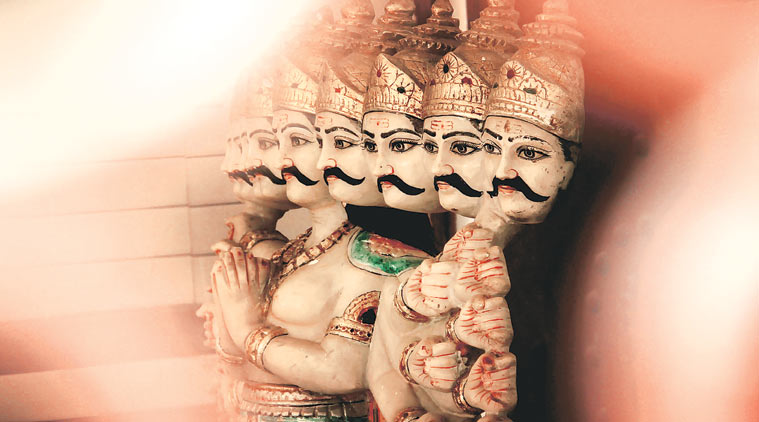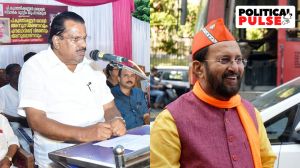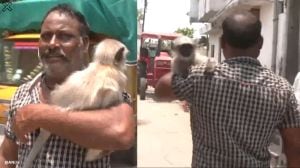- India
- International
Ravana in Uttar Pradesh
Why Bishrakh’s heritage should be protected
 A Ravana statue at Bisrakh village in UP, 30 km from Delhi. (Express Photo by Gajendra Yadav)
A Ravana statue at Bisrakh village in UP, 30 km from Delhi. (Express Photo by Gajendra Yadav)
I remember the village of Bishrakh in Uttar Pradesh for a number of reasons. It is a place I first surveyed with my historian-friend Upinder Singh in 1994. This, in fact, was part of the first independent field work I had undertaken and involved a survey of villages in Ballabhgarh in Haryana on the one hand and across the Yamuna, in the adjoining areas of Uttar Pradesh on the other. What made it different from anything I had experienced till then were the memories and observations of its rural inhabitants around ancient relics and mounds, and the generous manner in which these were elucidated to us.
What also made the experience memorable was the presence at Bishrakh of a massive mound, large parts of which were occupied by village homes, with occupation layers that extended back to 1000 BCE, and continuing well into the medieval period. So abundant was the presence of the finely produced painted grey ware whose antiquity goes back to the cusp of the second and first millennium BCE, that for my son who had visited Bishrakh with me, it became a kind of icon of what was worth collecting from old mounds. In later years, when I returned from the field, his first question used to be: Had I found painted grey ware? If the answer was “no”, he was instinctively disdainful of whatever else I may have discovered.
Above all, however, what stayed most vividly with me was neither Bishrakh’s high mound nor its ancient pottery. Instead, it was the charming presence of Ravana, the mythical transgressor of the Ramayana, there. Local legends associated the village with Vishrawas (locally pronounced as Bisheshwar), the father of Ravana. The similarity in the name of the village Bishrakh with Vishrawas was one evidence of it, we were told. In fact, a spot thickly covered with potsherds was pointed out as the spot where Ravana was born. Furthermore, from the mound, a large number of stone Siva lingas had been regularly recovered which could be seen in many parts of the village. Some of these were also kept in an open-air village shrine along with a decapitated Nandi bull sculpture and were regularly worshipped. Since Ravana is popularly represented as a Siva devotee, these Siva-related relics were treated as material evidence for the presence of the mythical “villain” here.
For me, schooled as I was in the tradition which generally associated Ravana either with Lanka or with the peninsular parts of India, this was an enormous learning experience. In terms of the Brahmanical tradition, Bishrakh would be geographically located in Kuru land and a segment that had very little to do with Rakshasas and their progeny. Unintimidated by such traditions, here were villagers proudly proclaiming a spot in their village as Ravana’s birthplace. As I now realise, this is not an unusual practice. People look at the past the way they like to, in ways that make sense to them. In the process, it is common to see elements of the past being creatively redefined — in this case, around Ravana and his “janmabhoomi”.
Such sculptural fragments and remains that one saw there are important for two other reasons as well, unconnected with their being treated as symbols of Ravana. First, what is so striking about Bishrakh is that by placing them on their shrine and in their mythology, villagers have ensured the survival of ancient antiquities in the vicinity of their settlement. The collections of artifacts, sculpture and architectural pieces in religious places of worship — in and around village shrines and city temples — are sometimes the only clues that have survived about their antique pasts. This practice, thus, needs to be integrated into our understanding and appreciation of the different ways in which ancient paraphernalia has survived in modern India. This is an excellent and, if I may say so, “non-western” conservation practice which has ensured the preservation of artifacts and sculpture close to their original contexts. This is not to suggest that destruction of sites and sculpture does not take place in rural India but only to underline that those images and antiquities which are perceived through and incorporated into a filter of local beliefs and practices, are more likely to be revered and preserved.

Secondly, the Nandi bull and the Siva lingas form our only evidence for the existence of a medieval Saiva establishment there. To put it another way, these archeological remnants of medieval culture have become available as a body of historical evidence because they are preserved in a dramatically visible way in the arena of folk worship. Their worship also speaks volumes for the ground reality and relevance of scriptural sanctions that strictly forbid any worship of broken/mutilated images. Texts dealing with the creation and installation of images (like the Pratimanalakshanam) specifically warn worshippers that “the image of a deity, if it be burnt, worn out, broken or split up, after its establishment or at the time of its enshrinement, will always be harmful. A burnt image brings forth drought, a worn-out one causes loss of wealth, a broken image forebodes death in the family, while one that is split up, war.” Unmindful of such proscriptions, a broken Nandi had been placed on the village shrine here meant to promote habitational bounty. Such beliefs and worship, incidentally, are exceedingly common across India and I have personally documented this in large parts of India — from Gujarat to Bihar and from Haryana to Karnataka.
That it is this nature of practice — in this case, the traditional reverence offered to Ravana in Bishrakh — which is now under threat is evident from the vandalism, reported by The Indian Express (August 11), that was wreaked on a Ravana idol in the temple there, by right-wing activists. This is unlikely to be a one-off incident. It may well mean that the intolerance shown by proactive die-hard Hindu elements towards the food habits of Indians will now be extended to their world of folk beliefs and worship.
EXPRESS OPINION
More Explained
Apr 26: Latest News
- 01
- 02
- 03
- 04
- 05











































